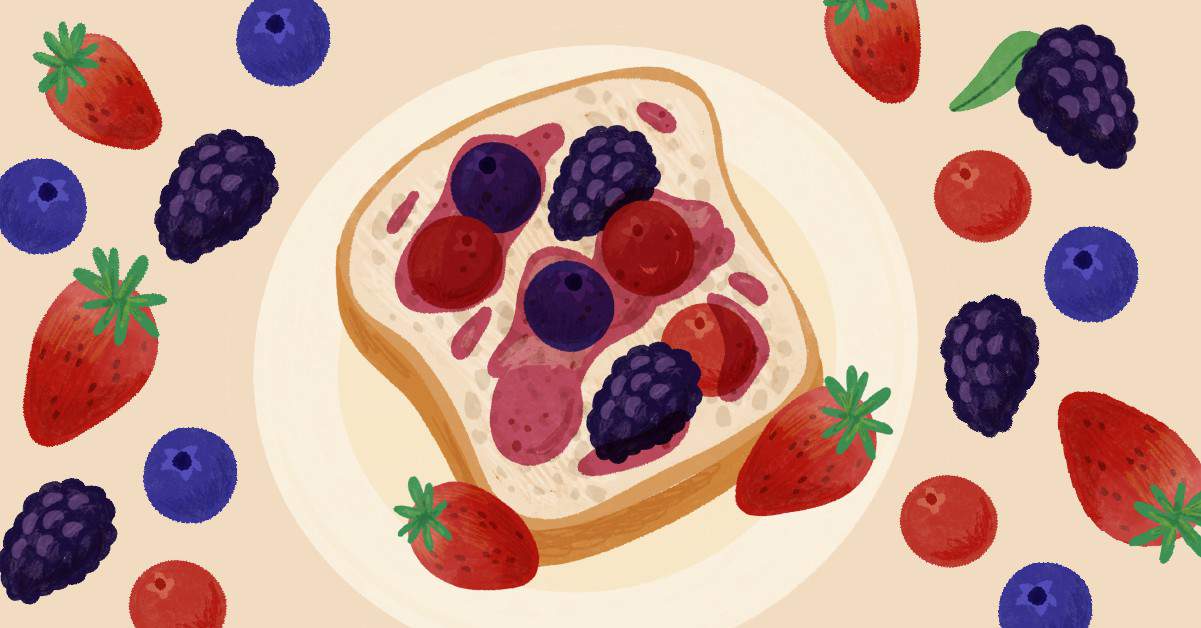Whether jam or jelly, compote or chutney, delicious fruit spreads can add sweet or savory flavor to lots of meals and snacks. Unfortunately, many fruit spreads are low in nutrients and high in extra sugar.
Does that mean you should pass on preserves? Not at all. You can keep marmalade on the menu by following our tips for choosing the right spread and making healthier fruit spreads at home.
What’s the Difference Between Different Fruit Spreads?
For a lot of us, fruit spreads might be familiar in only two forms: jelly and jam. While these are delicious options, a big, diverse world of fruit spreads beckons.
Chutney
Combining sweetness, acidity, and sometimes spicy heat, chutneys typically include an acid such as vinegar, both for its tart snap and natural food preservation qualities. Made of fresh fruit, dried fruit, and spices, chutneys often use less added sugar, making this fruit spread perfect for when you want a touch of sweetness and more texture.
Preserves
A wonderful middle ground of fruit and sugar, preserves consist of bite-sized pieces of fruit or small whole fruits, held together in a thick syrup. Preserves emphasize the fruit’s natural flavor over sweetness. Enough sugar or corn syrup is mixed in to suspend the fruit throughout the mixture, instead of letting it sink to the bottom.
Jam
Thick enough to use as a filling when baking yet soft enough to spread easily, jam is sweet and versatile. Jams typically rely on a higher proportion of sugar to chopped or crushed fruit than other spreads. Some jams also include added pectin, fruit’s natural starch, which helps spreads set, or thicken. Fun fact: Jams are made with only one fruit. If you combine two or more fruits, you technically have what’s called a conserve (which can include dried fruits or nuts too).
Jelly
Stiff and wiggly, jelly is all about the juice. Other spreads contain cooked down fruits. When making jelly, solids such as pulp and seeds are strained out, leaving only the juice. Jelly has a smoother texture and higher sugar and pectin content than other spreads.
Compote
Compotes are all about melding and enhancing the fruit’s natural flavors, with a soft texture. They consist of lightly simmered dried fruit and/or chopped or small whole fruits in a heavy sugar syrup. They may also include herbs and spices, along with a dollop of liqueur. Compotes can also be a great medium to work in savory flavors, such as black pepper, sage, or rosemary.
Marmalade
The texture of marmalades can be similar to jams and chutneys. However, this fruit spread highlights the brightness and bitterness of citrus. Marmalade’s hallmark satisfying bitter notes (and chewy texture) come from including small pieces of the citrus’s rind. Today’s marmalades can be made with traditional quince or sour Seville oranges, or lemons, kumquats, grapefruits, and other varieties of orange.

6 Tips to Make Healthier Fruit Spreads
You can make delicious, nutrient-dense fruit spreads that suit your dietary needs and preferences. Consider these tips when making your own at home.
1. Choose fruit that’s high in natural pectin
Whether as your star or a supporting role, many fruits are naturally high in thickening pectin including:
- Apples
- Apricots
- Blackberries
- Plums
- Pears
- Cranberries
- Citrus fruits such as kumquats and oranges
2. Use chia seeds as the base
With their natural ability to absorb lots of liquid and form a gel-like consistency, chia seeds thicken spreads while increasing their nutrient density by contributing heart-healthy omega-3 fatty acids, protein, and fiber. Using chia seeds as a base can help you get the fruit spread texture you want with minimal — or even no — cooking.
3. Use a natural sweetener such as maple syrup, honey, or dates
Natural sweeteners thicken and preserve spreads, too. A smaller amount can be a big flavor boost. Sweeten your next spread with:
- Dates
- Unrefined (or turbinado) sugar
- Honey
- Coconut sugar
- Maple syrup
4. Use acids such as lemon juice as a natural preservative
Acids such as vinegar and bottled lemon juice provide bright flavor, but they can also replace sugar’s natural food preservation qualities. By replacing some of the sweetener with natural preservatives such as vinegar or lemon juice, you can enhance flavor and help your spread last.
5. Use fermented fruit in place of some or all of the added sweetener
Lacto-fermentation brings forward fruit’s natural sweetness, enhances acidic and sour flavors, and boosts nutrition, including immune system support, probiotics, and vitamins. Along with being nutrient powerhouses, lacto-fermented fruits bring big flavor to your fruit spreads. Even better? Fermenting fruits can help you make spreads with less, or even no, sugar.
6. Crush fresh berries for a simple, no-fuss spread
Making preserves can evoke images of standing over a steaming pot for hours. In reality, you can make a simple fruit spread with little to no cooking. Crush or chop your fruits (or add whole small berries), and then mix with your preferred sweetener and seasonings as well as some chia seeds if you’d like to use them. Simmer until the taste and texture are to your liking. You can serve these simple, no-fuss spreads warm or store them for up to a week in the fridge.
Healthier Fruit Spreads Enhance Meals, Snacks, and Even Nutrition
Whether you want a firm jelly, bitter marmalade, or bright berry jam, try out different fruit spreads to see what you like most. Then consider making your own versions at home. You can boost not only the flavor each fruit spread can bring to your meals and snacks, but also the nutrition.
